While the effects of WA’s mining-industry slowdown linger, the persistent expansion of Perth shows promise that the state could be on the rebound. Progressive design and development on the commercial scene reveal a community that continues to look forward.
SMARTER PLANNING
"Our biggest challenge in WA is our planning system. Each small local council has different planning laws – some with outdated policies that inhibit good development. With Perth's population doubling over the next 30 years, we need a planning system that can help density happen in a smarter way"
Paul Blackburne, managing director of Blackburne.
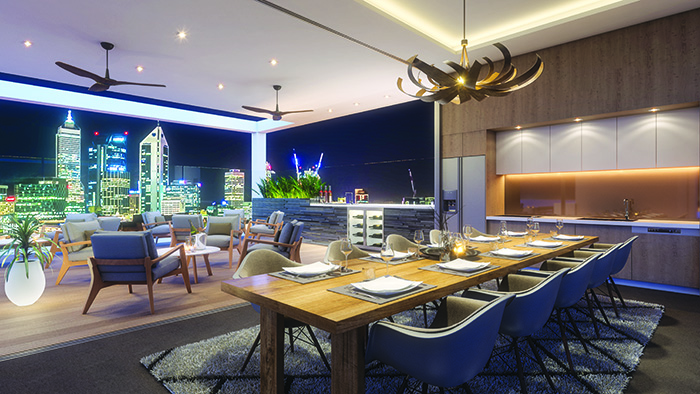
Positioned in a quiet pocket of the cultural precinct of Perth, and within walking distance of the CBD and Northbridge, Blackburne's Oracle Apartments offer the ultimate urban lifestyle.
ACTIVITY-BASED WORKING
"Successful environments, especially agile ones, do not lend themselves to
a 'one-size-fits-all' approach, especially for Activity-Based Working (ABW). To
achieve the true potential of ABW, the approach must be finely tuned to the
business and the people within it.
A recent example of a considered approach to ABW is King & Wood Mallesons in Perth – the space supports the company's strategic direction and desired culture. The ability to orchestrate privacy and confidentiality, and to coordinate noise and distraction were critical factors in the development of the workplace strategy by Geyer. The workplace allows for personalisation of space, shared access to natural light, effective and accessible storage, and the integration of mobile working technology."
Stirling Fletcher, Perth regional leader at Geyer.
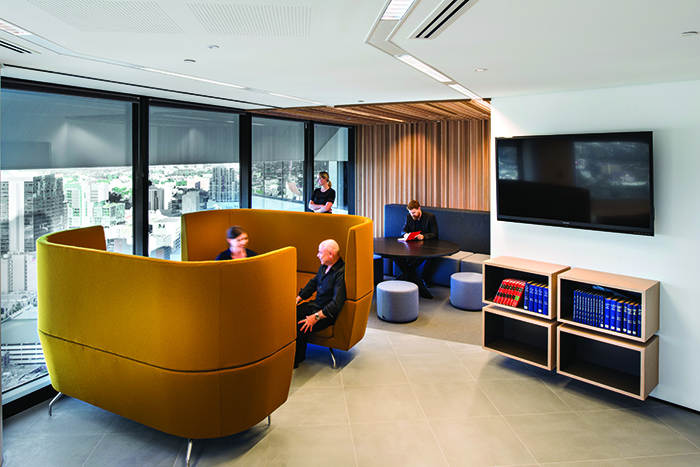
Popularity for Activity-Based Working (ABW) is on the rise, as seen here at King & Wood Mallesons.
A NEW AUSTRALIAN DREAM
According to Cameron Chisholm Nicol associate Jonathan Davis, the Great Australian Dream of a quarter-acre block, the home among the gum trees, and a big backyard for the kids is simply not that affordable in the long term. "That dream will now cost you in time, in travel, in distance and in lifestyle," he says.
Instead, a new Australian Dream is coming to the fore – a sustainable and socially responsible dream that minimises carbon footprint and enables proximity to family and friends, public transport, cafes, bars, restaurants and cinemas,
at an affordable price.
State planning policies created to facilitate transit and activity centre-oriented developments have led to a number of options for people to downsize, realising the benefits offered by apartment living.
"Our focus on optimising space, views, natural light and fresh air, and creating useable outdoor recreation spaces, adequate storage and communal facilities ensures these places are where people want to live," says Dominic Snellgrove, director of Cameron Chisholm Nicol.
The firm's projects masterplanned around the Cockburn Central train station exemplify the principles of good design in apartment living.
"Good design goes way beyond aesthetics – it's about creating vibrant, enjoyable places to live and work," says Dominic.

Helm in Port Coogee was awarded a Commendation for Residential Architecture – Multiple Housing at the 2015 WA Architecture Awards
(photography Greg Hocking).
LIFESTYLE AND LOCATION FOR BABY BOOMERS
Baby boomers and empty nesters, who were reluctant to move out of their larger homes post-GFC, are now embracing apartment living.
"The attraction of trading down to free up cash for lifestyle and travel aspirations, better locations closer to attractions, plus a move from high-maintenance homes to the convenience of a lock-up-and-leave, is driving the trend," says David Hillam of Hillam Architects.
The more amenities the better, with Hillam Architects' Aria Luxury Apartments in Swanbourne, Vantage Rivervale apartments, and Lumiere South Perth exceeding expectations, with hot spas, yoga spaces, infinity-edge pools, dining and lounge facilities, and outdoor cinemas.
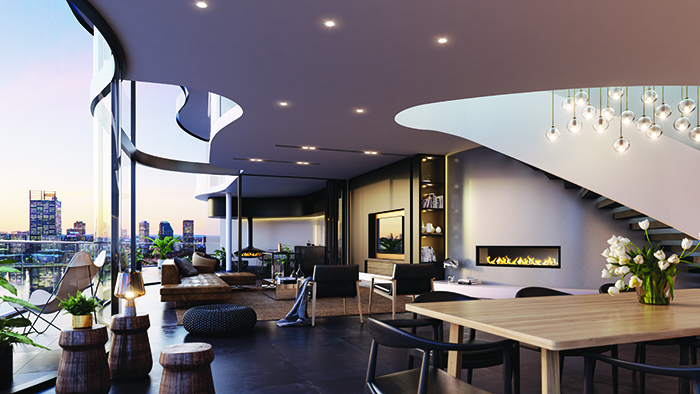
Unsurpassed city and river views at Lumiere apartments, combined
with greater facility and amenity, are proving a popular choice for the baby boomer demographic.
LIGHTING THE WAY
Utilising creative lighting solutions in conjunction with public art and spaces is an exciting new way of bringing Perth's communities outdoors to enjoy their surrounding environment.
Asked to develop artwork for two sound walls in Murdoch, artist Rick Vermey created locally relevant imagery adjacent to the Quenda Wetlands. His collaboration with lighting specialist Martin Klaasen of Klaasen Lighting Design saw a concept that forms a striking, recognisable landmark feature for road users.
The City of Fremantle, in its effort to bolster community activities, also worked with Klaasen Lighting Design and saw a positive and supportive reaction from the public in response to lighting up the rocky limestone Arthur Head cliff and Roundhouse area.
Gerry de Wind, Mondoluce.
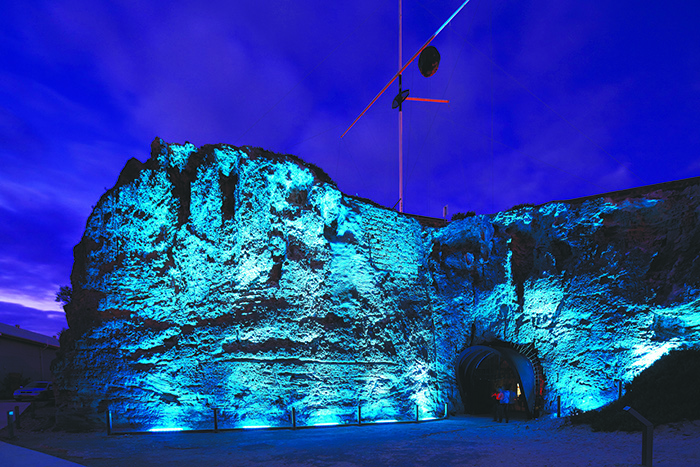
The impressive lighting effects at Fremantle's Arthur Head cliff.
WHAT'S OLD IS NEW
"Commercial clients are becoming more comfortable with using recycled materials such as crushed brick and concrete, recycled timber and glass, and stone mulching in landscape projects.
"Furthermore, minimally processed materials such as uncut stone, wood and bamboo are also gaining popularity, as they reduce manufacturing and processing requirements while also providing beautifully rich and earthy/natural textures."
Andrew Rydings, construction manager at Phase3 Landscape Construction.
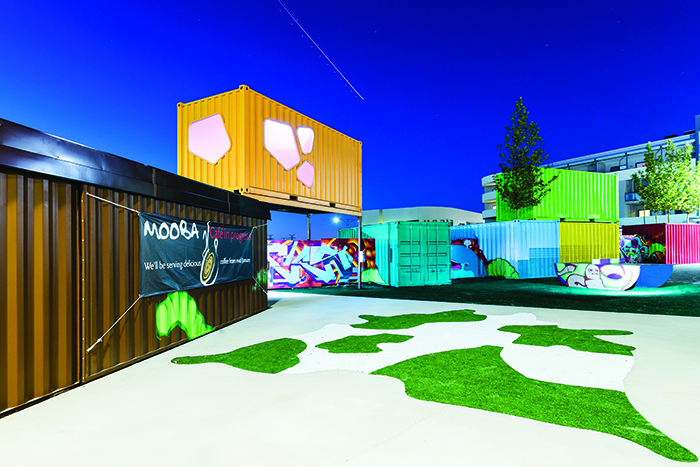
Recycled sea containers at Cockburn Town Square reflect functionality and forward-thinking sustainable design.
STRONGER DESIGN, GREATER COMMUNITIES
"In 2014, the WA Department of Planning released its position paper called Planning Makes it Happen: Phase Two Blueprint for Planning Reform, which, amongst other initiatives, includes a proposal to mandate the use of registered architects for the design of multi-storey, multi-residential projects. This is a planning initiative that is modelled on a NSW policy that has been in place for 12 years, and is widely acknowledged as leading to significantly improved design outcomes for apartment buildings in that state.
"At a time when cities across the country are planning denser communities as a key strategy for developing sustainable futures, it is time for all State Planning Authorities to learn from the NSW experience and to move towards replicating their successful policy.
"In Western Australia, there are no licensed building design professionals other than architects.
"The design of buildings, especially medium- and high-density housing, directly affects quality of life for occupants and community. The design of our built environment influences security, health, financial and environmental sustainability, and social wellbeing. To create better communities for our future, it is essential to strive to get the best designs.
"Just as builders, electricians, plumbers and painters on complex building projects need to be licensed, it makes sense that those buildings be designed by registered architects.
"The phase two planning reform proposal to mandate the use of registered architects for the design of multi-storey, multi-residential projects should be adopted as part of a broad strategy for building better communities for
the future of WA."
David Karotkin, Sandover Pinder.
.jpg)
Studios 54 by Hill Thalis Architecture + Urban Projects consists of four apartments, a shop and a roof terrace on a 126sqm site (photography Aaron Murray and Alexander Rink).
SUPPORT FOR PUBLIC ART
"The City has allocated a total of $717,885 from its 2015/16 budget to support its public art projects and programs, including temporary and enduring public art commissions.
"We allocate both capital and operational funds from the annual budget to resource public art projects and programs in line with the priorities outlined in the Public Art Strategy. The budgeted amount changes each year, based on different focus areas and programs.
Public art is a source of pride and identification in our community. It is accessible to everyone at no charge, adding to the attractiveness and vitality of our city."
City of Perth Lord Mayor Lisa Scaffidi.
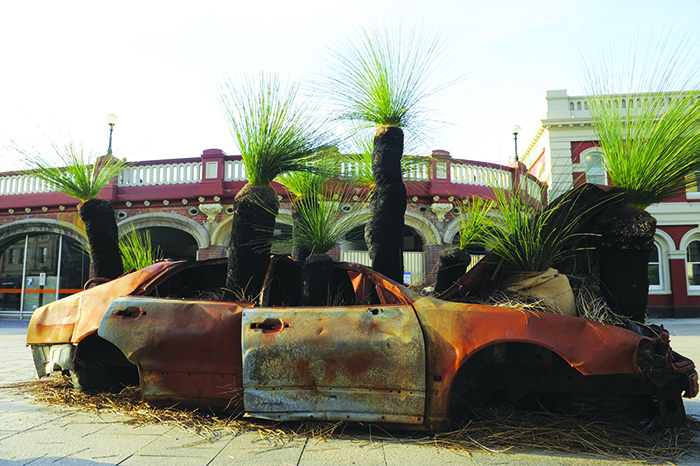
Victory or Revenge? by Tim Burns, as part of the 2015 TRANSART: RED program (photography Neil Wallace).
FLIGHT TO QUALITY
QUBE Property Group managing director Mark Hector says challenging market conditions are giving commercial tenants an opportunity to relocate from lower-grade older buildings into superior new premises.
Driven by developers who are flexible, offer a choice of quality premises, and are willing to put together an agreement that suits both parties, the flight to quality
has been anticipated for some time.
"Tenants recognise that now is a good time to trade up to new buildings with significant end-of-trip facilities and superior energy and environmental ratings at
a competitive price," Mark says.
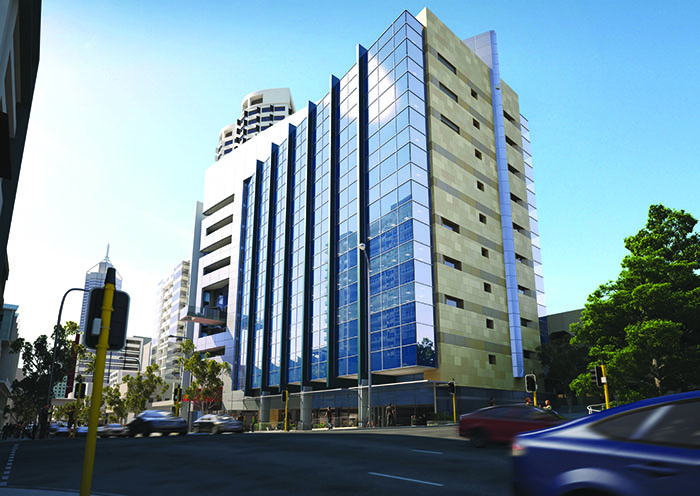
More than half of QUBE Property Group's 999 Hay Street was already secured by tenants before its completion, highlighting the demand for higher quality and more flexible commercial spaces.
DESIGN FOR THE PEOPLE
"We are finding the commercial market has taken a swing in the direction that designers seem to be designing for the people, and not just the space.
Product is selected and custom-designed more and more currently with employees' needs in mind, in order to create a desirable work life and environment. We find it is no longer a chair, a desk and a lounge in the breakout area. Instead, it is a full ergonomic task chair with a height-adjustable disking system, and a high-back lounge with built in data and power – all with the end-user's comfort in mind."
Joseph Merlino, managing director of District.
BOUTIQUE BENEFITS
Interest in boutique apartment developments is on the rise, with buyers drawn to the individuality, design flexibility and sense of community they offer.
"Typically low-rise buildings with no more than about 60 apartments, these smaller developments offer significant benefits over their towering, people-packed high-rise counterparts," says Mark Hector, managing director at QUBE Property Group. "Not only do boutique apartment buildings have a warmer, friendlier feel, but they also don't feel crowded, plus there's more opportunity for the developer to vary the layout and size of the apartments."
The smaller developments – like Sentral, QUBE Property Group's 47-apartment development adjoining Highgate's trendy cafe and entertainment precinct near Beaufort Street – are typically close to all the inner- city action, yet they tend to be just off the main drag, in quieter locations but without losing any amenity benefits.
What's more, boutique apartment developments don't usually have underutilised and expensive-to-maintain on-site amenities such as gyms or pools, which means lower strata fees, and the opportunity for residents to pay individually to go to the gym or sports centre of their choice.
As Perth's apartment market continues to grow and evolve, the boutique projects are not only providing balance and choice, but their wide appeal means they are also more likely to achieve the necessary pre-sales to get off the ground when the market is competitive.
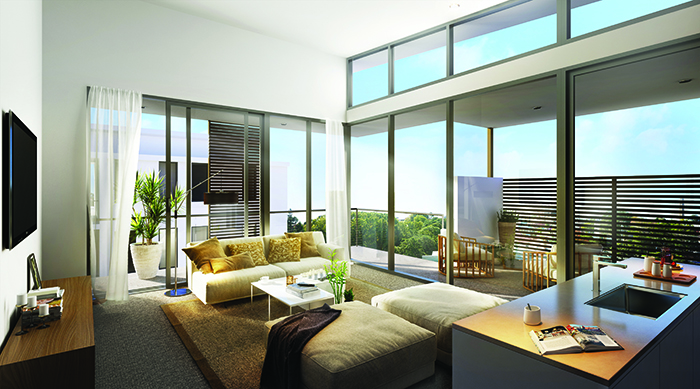
QUBE Property Group's boutique Sentral Apartments were designed by Hames Sharley.
SIZE MATTERS
Following the east-coast trend – where large projects of 300 to 1000 apartments over 70 storeys is considered normal – Perth is now seeing greater numbers and heights in its own apartment developments.
"Five years ago, apartment projects containing more than 50 apartments were considered large in Perth," says David Hillam of Hillam Architects. "Now, this type of number would be considered a boutique development in Perth."
The benefits of large, tall apartment developments are many, and include less
impact on the immediate precinct, compared to short, squat buildings, while providing better access to views and desirable amenities. This further activates vital communities, and reduces urban sprawl and its impact on the environment and government budgets.
The CBD, South Perth, Mount Pleasant, Victoria Park and Cockburn are showing signs of big growth in large apartment development, while Edge Visionary Living will soon launch the 17-storey Arthouse Apartments.
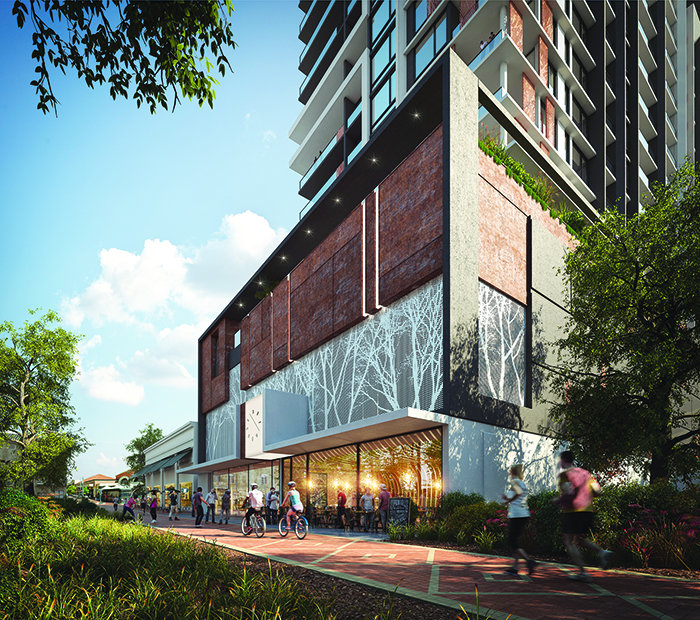
The 17-storey Arthouse Apartments project is expected to change the face of Joondalup.
SHAPING OF 'PLACE'
The World Architecture Festival is the world's largest international architectural event. Two of JCY Architects & Urban Designers projects – Baldivis Secondary College and ECU's 'Ngoolark' Building 34 Student Services – have been shortlisted for International Award nominations. The projects are a reflection of the practice's belief in extending the design beyond just the classroom or building, and recognising the need to invest in the urban life of the campus's external environment and community.
JCY principal Glenn Russell and marketing manager Simone Wilkins explain that greater importance is being placed on the quality of the public realm, and developing a student-focused campus. "Providing settings where students are attracted to study and participate in campus life is an essential balance in furthering education," they say.
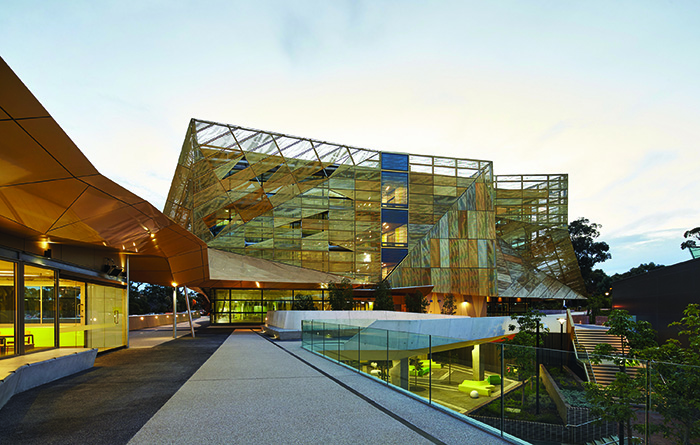
ECU's 'Ngoolark' Building 34 Student Services is shortlisted for an International Award nomination at the 2015 World Architecture Festival.
CULTURE, CREATIVITY AND ECOLOGY
"Perth has been at the centre of enormous structural change in the last decade, which has ultimately provided the 'bones' for a great city. Given our extraordinary culture, creative depth and ecological purity, we have all the ingredients for success.
"Large or small, this century's cities will survive – or not – depending upon their character in these areas.
"This is much more than thinking just about buildings – it is carefully composing the theatre of our public domain and orchestrating the experiential qualities of street life. Our cultural worth shouldn't sit in a single fortress, it should spill out into our streets.
"We have seen ourselves on the world stage in recent times, and the opportunity to define ourselves in the global spotlight lies in our hands right now."
Steve Woodland, design director of Cox Howlett & Bailey Woodland.
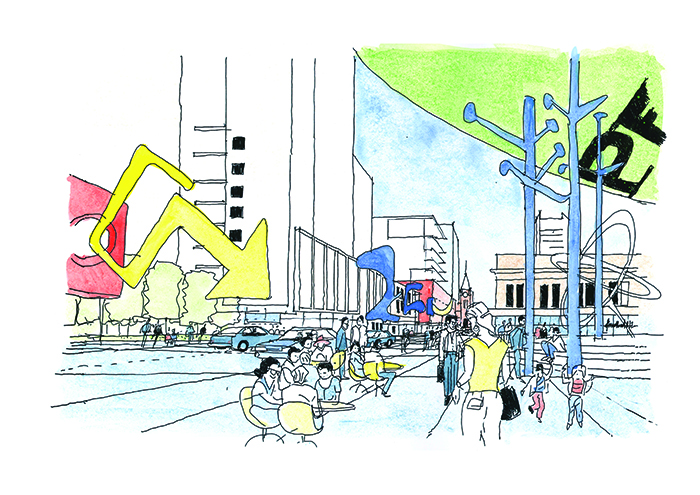
Barrack Street Cultural Connect, sketched and painted by Steve Woodland.
CANNING BRIDGE PRECINCT
"The new Canning Bridge Structure plan is a brave and aspirational collaboration between the City of Melville and the City of South Perth.
"This generational project will see the residential population rise from 3800 to 24,000, and the commercial population from 1700 to 7900.
"The implementation of the re-zoning will create a new high-density, transport-oriented node that will be a fulcrum between Perth City and Fremantle.
"Within this precinct, the criteria for planning discretion demands design excellence, high levels of sustainability and demonstrable community benefit."
James Thompson, McDonald Jones Architects
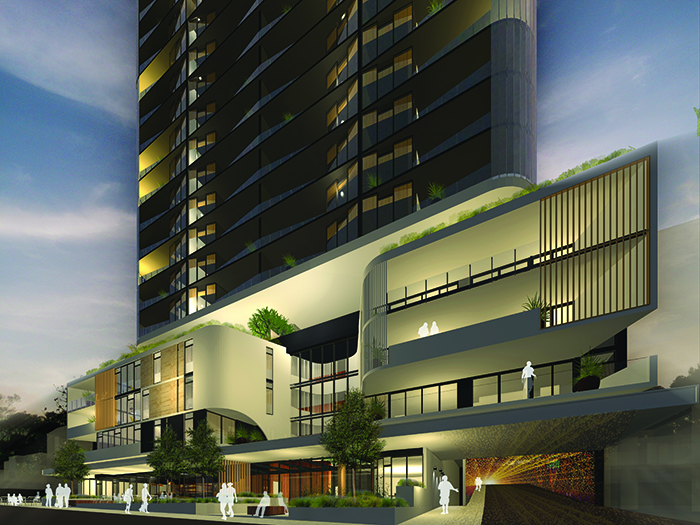
The mixed-use residential development at Kishorn and Ogilvie roads, Mount Pleasant was the first planning application in the Canning Bridge Precinct.
GREAT EXPECTATIONS
The challenge for better facilities and neighbourhood connectivity has been
set, as the late baby boomers and Gen Xs start to move towards retirement in the
next 15 years.
As housing options become far more varied, the needs and expectations of the public are increasing. It's important that retirement housing providers don't fall behind in the crowded marketplace.
"The 70-year old is the new 60-year-old in many respects, and the assumption that they all want the same housing type is now not realistic," says Gary Mackintosh, associate director of Hames Sharley. "The preference is to be close to family, amenity, shopping and restaurants."
More commonly, retirees and the elderly are looking to stay in the family home, live in a granny flat, move into a more accessible home in the same location (such as moving out of a two-storey home), downsize to an area with improved amenity and location, and, if necessary, move to aged-care facilities due to health.
"It is the group of downsizers and people with higher expectations that may have the most effect on the traditional retirement living provider," Gary says
The question is, how can retirement-living providers retain their market share as these market pressures and other choices are taken up by their traditional residents? Watch this space for big changes to come.
-
Research by Master Builders and Y Research has revealed one in five new dwellings in Perth will likely be apartments by 2020 – double the rate that it was at the turn of the decade.
-
Renewed interest and investment in Fremantle is seeing a combined level of private and public investment of more than $1 billion in civic, commercial, residential and retail developments.
-
Peet Limited and BGC Development's Invita Apartments at The Village at Wellard is the first transit-oriented community on Perth's southern train line, winning the 2015 Affordable Development award at the UDIA National Awards for Excellence.
-
Colliers International estimates that 188,281sqm of office space is currently being built within the CBD, all of it new construction.
-
According to Property Council of Australia's Keep WA Growing report by Urbis, $4.5 billion of infrastructure investment and $2.4 billion of unlocked property development would enable $27 billion of economic activity for WA, and generate 32,500 new jobs.
-
Without any additional transport capacity in 2031, not investing in MAX Light Rail is expected to cost Perth $16 billion in productivity loss.
-
According to Colliers International's research and forecast report, office tenants are receiving record levels of incentives as owners compete for their occupancy, with Perth CBD currently having the highest A-grade incentives in Australia at 38 per cent. Crown Towers Perth – the new luxury 500-room hotel at Crown Resorts – will be Perth's largest hotel, with completion expected in 2017.